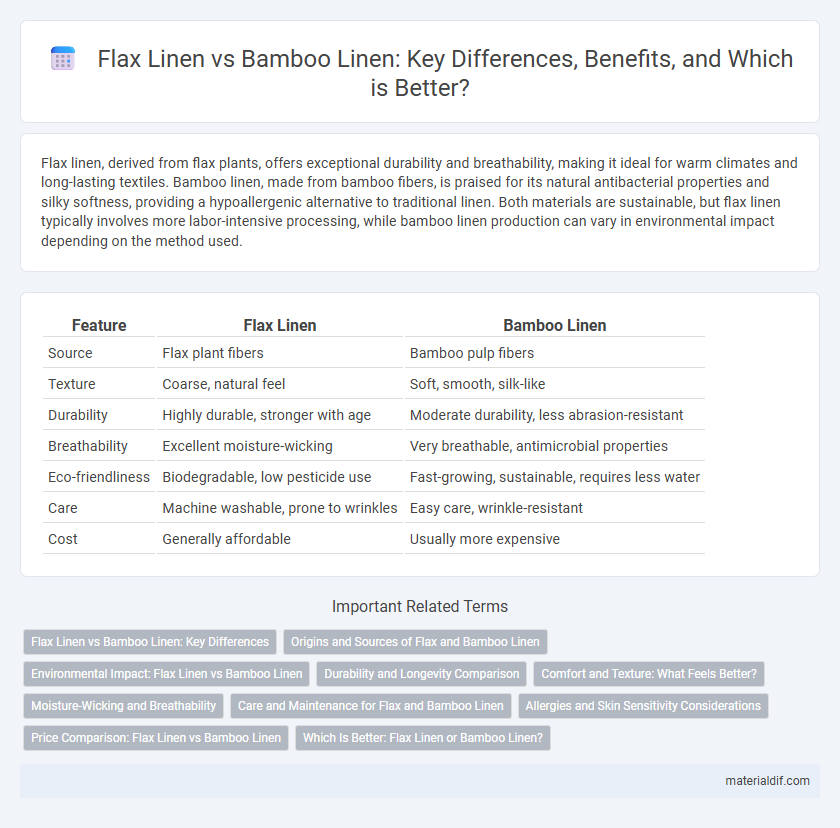Flax linen, derived from flax plants, offers exceptional durability and breathability, making it ideal for warm climates and long-lasting textiles. Bamboo linen, made from bamboo fibers, is praised for its natural antibacterial properties and silky softness, providing a hypoallergenic alternative to traditional linen. Both materials are sustainable, but flax linen typically involves more labor-intensive processing, while bamboo linen production can vary in environmental impact depending on the method used.
Table of Comparison
| Feature | Flax Linen | Bamboo Linen |
|---|---|---|
| Source | Flax plant fibers | Bamboo pulp fibers |
| Texture | Coarse, natural feel | Soft, smooth, silk-like |
| Durability | Highly durable, stronger with age | Moderate durability, less abrasion-resistant |
| Breathability | Excellent moisture-wicking | Very breathable, antimicrobial properties |
| Eco-friendliness | Biodegradable, low pesticide use | Fast-growing, sustainable, requires less water |
| Care | Machine washable, prone to wrinkles | Easy care, wrinkle-resistant |
| Cost | Generally affordable | Usually more expensive |
Flax Linen vs Bamboo Linen: Key Differences
Flax linen is derived from the flax plant's fibers, known for its durability, breathability, and natural moisture-wicking properties, making it ideal for hot climates. Bamboo linen, made from bamboo pulp, offers a softer texture with inherent antibacterial qualities and superior moisture absorption but tends to be less durable than flax linen. While flax linen is celebrated for its rustic texture and long-lasting performance, bamboo linen is preferred for its silky feel and eco-friendly, sustainable growth.
Origins and Sources of Flax and Bamboo Linen
Flax linen is derived from the flax plant, primarily cultivated in Europe and parts of North America, known for its long, strong fibers ideal for high-quality linen fabric. Bamboo linen, on the other hand, is produced from bamboo grass predominantly grown in China and Southeast Asia, valued for its sustainable and fast-growing nature. The origins of flax involve traditional agricultural methods, whereas bamboo linen benefits from rapid bamboo regrowth and minimal pesticide use, impacting the environmental footprint of each textile.
Environmental Impact: Flax Linen vs Bamboo Linen
Flax linen, derived from flax plants, requires significantly less water and pesticides compared to bamboo linen, making it more environmentally sustainable. While bamboo grows quickly and regenerates without replanting, its processing often involves chemical-intensive methods that can harm ecosystems. Choosing flax linen supports lower carbon footprints and reduced chemical pollution, contributing to a greener textile industry.
Durability and Longevity Comparison
Flax linen, derived from the flax plant, is known for its exceptional durability and can last for decades with proper care due to its strong natural fibers. Bamboo linen, made from bamboo pulp, tends to be softer but generally has a shorter lifespan and is more prone to wear and tear compared to flax linen. Flax linen's superior tensile strength and resistance to pilling make it a preferred choice for products requiring long-lasting performance.
Comfort and Texture: What Feels Better?
Flax linen, derived from the flax plant, offers a crisp texture with excellent breathability, making it ideal for hot climates and sensitive skin. Bamboo linen, made from bamboo fibers, provides a softer, smoother feel with natural moisture-wicking properties and hypoallergenic benefits. When comparing comfort and texture, bamboo linen typically feels gentler and silkier, while flax linen maintains a sturdy, slightly coarse texture that softens over time with use and washing.
Moisture-Wicking and Breathability
Flax linen, derived from the flax plant, boasts superior moisture-wicking properties due to its natural fiber structure that absorbs and releases moisture efficiently, keeping the skin dry and comfortable. Bamboo linen, made from bamboo pulp, offers excellent breathability with its porous fibers that promote airflow and help regulate temperature, reducing sweat buildup. Both fabrics excel in moisture management, but flax linen provides a slightly more durable and crisp texture, while bamboo linen is softer and better suited for sensitive skin.
Care and Maintenance for Flax and Bamboo Linen
Flax linen requires gentle washing in cold water and air drying to preserve its natural fibers and maintain durability, while bamboo linen benefits from similar care but demands extra caution to avoid high heat that can damage its softness and elasticity. Both fabrics resist wrinkles and become softer with each wash, but flax linen typically exhibits greater longevity under proper care. Using mild detergents and avoiding bleach or fabric softeners prolongs the life of both flax and bamboo linens, ensuring their sustainable appeal and performance.
Allergies and Skin Sensitivity Considerations
Flax linen, derived from the flax plant, is naturally hypoallergenic and breathable, making it ideal for individuals with sensitive skin or allergies due to its moisture-wicking and antibacterial properties. Bamboo linen also offers excellent softness and antimicrobial benefits, but its processing often involves chemical treatments that may irritate highly sensitive skin. Choosing between flax and bamboo linen requires considering the manufacturing process's impact on skin sensitivity alongside the innate natural fiber benefits.
Price Comparison: Flax Linen vs Bamboo Linen
Flax linen typically commands a higher price due to its traditional cultivation and labor-intensive processing compared to bamboo linen, which benefits from faster growth cycles and more sustainable farming methods. Bamboo linen offers a cost-effective alternative with comparable softness and durability, making it attractive for budget-conscious consumers seeking eco-friendly textiles. Market prices for flax linen can range from $20 to $50 per yard, while bamboo linen generally falls between $15 and $35 per yard.
Which Is Better: Flax Linen or Bamboo Linen?
Flax linen, derived from the flax plant, offers superior durability, natural breathability, and excellent moisture-wicking properties, making it ideal for long-lasting, comfortable textiles. Bamboo linen, made from bamboo fibers, excels in softness and antibacterial qualities but may lack the robustness and texture consistency of flax linen. Choosing between flax linen and bamboo linen depends on whether you prioritize longevity and resilience or enhanced softness and antimicrobial benefits.
Flax Linen vs Bamboo Linen Infographic

 materialdif.com
materialdif.com